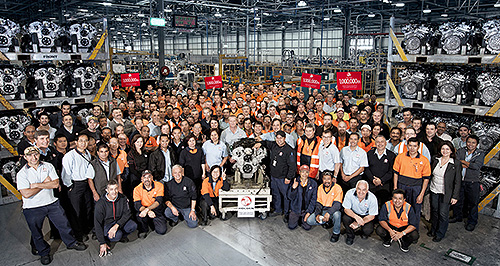News - HoldenDoomed Holden engine plant chalks up milestoneOne in a million: Holden’s engine plant workers celebrate a rare happy moment with the production of the one millionth High Feature V6 at the Port Melbourne plant. Millionth Holden V6 comes off the Port Melbourne line as workers count the days14 May 2014 WORKERS at Holden’s doomed engine plant celebrated a bitter-sweet milestone yesterday when they produced the one millionth High-Feature V6 at the 11-year-old Victorian factory. The line-off celebration at the Port Melbourne Holden Engine Operations plant near its Fishermans Bend headquarters came one day after GM Holden posted a record $553.8 million loss. The ceremony also came just hours before last night’s federal budget in which government assistance for auto industry workers facing redundancy was slashed. The Holden engine plant’s 235 workers will be out of a job when the plant shuts in 2016, about a year before Holden’s car assembly factory in Elizabeth, South Australia, closes its doors forever. Holden Engine Operations plant manager Martin Merry said the millionth engine milestone was a testament to the skills of the employees who work at the facility. “Our mission is to build the ‘world best engines’ and we believe we do,” he said. “Over one third of the engines built at Fishermans Bend are fitted into Holden’s locally-produced VF Commodore and Calais vehicles,” said Mr Merry. “These world-class engines also power vehicles in North America, South America, Europe and Asia, including the Chevrolet Alpheon, Buick GL8 and the Opel Antara.” The closure of the Port Melbourne factory will bring the curtain down on 66 years of engine manufacturing by Holden at the site. More than 10 million Holden engines have been turned out by the local company since it started building the 2.15-litre six cylinder ‘grey’ engine for the original 48-215 ‘FX’ in 1948. The plant stepped up to the L6 ‘red motor’ six for the EH Holden in 1963, and then the first V8 engines – the 253 and 308 – for the HT range, including the first Monaro, in 1969. The company built 4.7 million four-cylinder Family II engines between 1981 and 2009 in one of the most successful Australian automotive export programs in history. In 2003, an all-new $400 million plant began building the High Feature V6 to replace a Buick-sourced 3.8-litre V6 for Commodore and also for export to GM subsidiaries such as Buick, Chevrolet, Pontiac, Opel and Saab, as well as external customers such as Alfa Romeo. Holden says it currently makes 34 variants of the V6 engine, ranging from the potent 2.8-litre Turbo used in Opel/Vauxhall’s Insignia VRX/OPC to an LPG-capable 3.6. More than a third of the factory’s engine output is shipped to Adelaide for the Holden Commodore, with the remainder going offshore to countries such South Korea, China and Germany. A decline in Australian large car sales, including Commodore, has been compounded by a fall in export markets as consumer preference has swung to four-cylinder cars and, in the case of the Thai-built Rodeo ute, diesels. The death of Saab and termination of a supply contract to Alfa Romeo shut other export avenues. While the plant was built to make 900 engines a day or 240,000 engines a year, production has slipped to below 80,000 a year. The one millionth High Feature V6 engine – a 3.6-litre SIDI (spark ignition, direct injection) version as employed in the Commodore SV6 and Calais V6 will be retained at the Holden engine plant, presumably until the plant shuts.  Read more |
Click to shareHolden articlesResearch Holden Motor industry news |
















Facebook Twitter Instagram